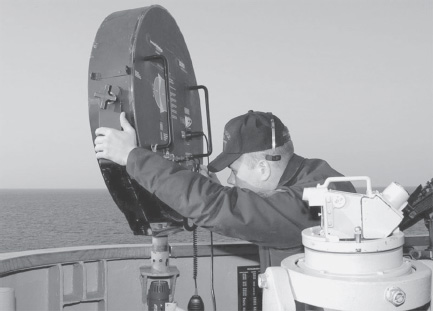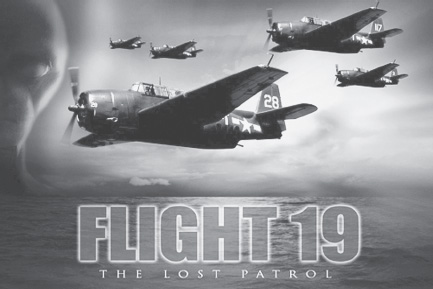Secret Journey to Planet Serpo (21 page)

8. Sound weapons.
As reported in the Team Commander's diary and previously discussed, the Eben guide accompanying the team in their exploration of the planet had some sort of weapon that projected a sound wave and repelled a dangerous creature encountered by the team in their travels. In this case, the Commander described the creature as “like an armadillo.” There has been extensive R&D in this country and abroad in the use of acoustic weapons. We have already developed the capability to use sound in certain frequencies to disperse crowds, and we can already use powerful sound waves to disorient and to render neurological damage. Development of an acoustic weapon that kills is clearly within our reach.

Long-range acoustical device, developed by the Navy
18
THE MOVIE
I really found my faith when I learned that the government was opposed to the film. If NASA took the time to write me a twenty-page letter, then I knew there must be something happening.
S
TEVEN
S
PIELBERG
Spielberg tells me about the film. It's about UFOs, he says, but it is not science fiction. He calls it “science fact.”
B
OB
B
ALABAN, ACTOR IN
C
LOSE
E
NCOUNTERS OF THE
T
HIRD
K
IND
THE SPIELBERG MAGIC
The Serpo story took on a new dimension when people started to realize that the Steven Spielberg movie
Close Encounters of the Third Kind,
released in 1977, may have been a fictionalized version of the actual event. The story, revealed twenty-five years after the movie was released, came clothed with a convincing aura of believability by virtue of the retrospective appreciation of the link to the movie, which had become a landmark film on its own merits. That appreciation, and the fact that
Close Encounters
did become an enduring classic, is a testament to the startling neorealistic way that Spielberg tells fantastic stories. In Spielberg movies, the unbelievable becomes very believable. Because of the way that fact and fiction are seamlessly woven together, the audience leaves the theater convinced, at a deep level, that what they just saw actually happened. That technique explains the impact and success of his first major movie,
Jaws
. Amazingly, in that film, he was able to achieve that effect even though he had to work with a clumsy mechanical shark. So, when the Serpo revelations appeared on the Internet in November 2005, they fell on the already prepared public consciousness due to the power and lingering effects of
Close Encounters,
which had, by then, achieved a permanent place worldwide in the mass culture.
PUBLIC ACCLIMATION
Many in UFO circles have come to believe that Steven Spielberg has an inside track on top secret military information, and that he doesn't just “make this stuff up.” There is some evidence that he has been chosen by the Pentagon, because of his neorealistic filmmaking skills and his popularity, to participate in a plan for the slow release of classified information, the so-called “public acclimation program.” Belief in the likelihood of that connection is supported by his choices of subject matter. Several of his films can easily be related to possible government/military agendas for the dissemination of secret information in a way calculated to win public sympathy. For example, in
E.T.: The Extraterrestrial
, released in 1982, we respond with affection to a rather grotesque alien creature, who becomes lovable by virtue of his “heart light.”
But in the case of
Close Encounters of the Third Kind,
the motivations are less clear. In fact, they are downright mysterious. One must ask the question: If this movie was part of the public acclimation program, why was it released while this top secret DIA/Air Force operation was still in progress? Spielberg began filming
Close Encounters of the Third Kind
in 1976. But the Serpo astronauts did not return to Earth until 1978. If the goal was to condition the public to an eventual revelation of the interstellar exchange program, that information would not have been released until the program was successfully completed, because it could have ended in disaster if the astronauts never returned to Earth. Furthermore, if it is suggested that perhaps it was Dr. J. Allen Hynek who gave Spielberg all the details of the Serpo operation, that likelihood can be easily dismissed. Hynek was the main UFO/ET technical consultant for the film and therefore was well-placed to inform Spielberg.
However, despite Hynek's long association with secret government UFO activity, nothing he ever wrote or said gives any hint that he knew anything at all about Project Serpo. Furthermore, there is every reason to believe that Hynek's participation was largely ceremonial. He was brought into the movie partially because he had conceived the “close encounters” scale in his book
The UFO Experience,
published in 1972, and this was a way of compensating him for the rights to the title. He himself said that his assistance with the film was rather superficial, and that he was mainly interested in learning more about how movies are made. As perhaps further compensation, he was given a cameo role in the last scene of the movie.

Dr. J. Allen Hynek
THE SCRIPT
By 1974, Spielberg had become identified as one of the rising directorial stars in Hollywood. He was one of the prominent members of the “movie brats” generation. They, especially George Lucas, Martin Scorsese, Francis Ford Coppola, and Brian De Palma, were the talented young directors of the 1970s who were clearly destined for great things. Spielberg's work on
Sugarland Express,
and the huge success of
Jaws
got him a longterm contract with Universal and the privilege of choosing his own projects. He was also free to work with other studios. He was given a semi-private bungalow on the Universal lot and was meeting the right people. He became friendly with Michael Phillips who, together with his wife Julia, were codirectors of Phillips Productions. They were riding high, at that time, having produced
The Sting,
which collected a basket of Academy Awards including Best Picture of 1973. Julia Phillips considered Spielberg one of the most talented people in Hollywood, and she pushed for a project with him. He told her he wanted to make a film about UFOs. She was all for it and began to assemble the pieces to make it happen. Phillips was in the middle of the production of
Taxi Driver
at that time, working with screenwriter Paul Schrader and David Begelman, president of Columbia Pictures. Schrader had written a script he called
Kingdom Come
about a dedicated civilian UFO investigator who gets in trouble with the Air Force. In the end, he decides to leave the planet and go off with his alien friends. Sci-fi was an anomaly for Schrader, who was better known for his work with harsh realism. Phillips brought Schrader's script to Spielberg, who said it was a good starting point, but would need an extensive rewrite. Phillips bought the script and Spielberg changed the name to
Close Encounters of the Third Kind
. She then easily persuaded Begelman, who immediately liked the concept, to have Columbia finance and distribute the movie.

Hollywood producer Julia Phillips (1944â2002)
According to Julia Phillips, in her book
You' ll Never Eat Lunch in This Town Again,
Spielberg sat down and rewrote the entire script in one weekend in 1975 at the Sherry Netherland Hotel in New York City, so that almost none of Schrader's work remained in the finished product, and Schrader ended up with no screenwriting credit. For Spielberg to have written such a complex screenplay so fast, in a hotel, without doing the research this script obviously required, would indicate that the story was given to him in advance. Since we now know that all the facts of the screenplay was in accord with the actual events of Project Serpo, that is the only plausible conclusion. The script became basically locked in place after that, with only minor modifications approved by Spielberg. That was a very unusual process in Hollywood, where screenplays are generally written by screenwriters, not directors, frequently take weeks or months to write, and normally go through many changes, based on the input of the producers and studio execs. Not this one. With the backing of Julia Phillips and Begelman, nobody but Spielberg, or someone he recruited, could change one word.
A SECRET SET
And then there was the secrecy. The
Close Encounters
set near Mobile, Alabama, took on the aspect of a top secret military facility. According to John Baxter in
Steven Spielberg: The Unauthorized Biography:
Mobile became the most hermetic of closed sets. Cast and crew worked, ate, sometimes even slept inside the stifling hangar, which 150 tons of air-conditioning equipment, enough for thirty large houses, did little to make habitable. . . . Nobody entered without a name badge. Even Spielberg himself, who lived in a Winnebago parked outside, was briefly barred when he forgot his. Scripts were numbered and distributed on a need-to-know basis. Most actors got only their own lines.
It's understandable and not unusual for directors to not want plot information leaked in advance of the planned publicity blitz. But they also want to build advance interest in the movie, so small, controlled leaks are desirable. In this case, the security was so severe that, clearly, something else was operating. It would be fair to speculate that Spielberg perhaps knew that he was dealing with the release of highly classified information and didn't want to risk having the government shut him down on the basis of the compromise of national security.
THE MOVIE COMPARED TO THE EVENT
If the Serpo information was not given to him by the military as part of public acclimation, and if he didn't get it from Hynek, then from what source did Spielberg obtain all the correct details of a program that was so super-secret and compartmentalized that only a very few top intelligence and Air Force operatives knew anything about it? Very likely, President Johnson himself was kept out of the loop. Johnson was not known to have been among the sixteen in the diplomatic greeting party at the first landing of the Eben craft in April 1964 near Holloman Air Force Base. In chapter 8, we discussed the fact that the aliens decided not to take the astronauts at that time, even though they were ready and waiting in a bus at the landing site, but rather to just take the ten dead bodies of their Eben compatriots, and that landing was not depicted by Spielberg, But he had all the basic facts right about the second landing in July 1965 at the Nevada Test Site. The movie agrees completely with all the details revealed by Anonymous and sent to the Serpo website by Victor Martinez. The details that Spielberg changed were mostly for dramatic effect. He knew that the visit was prearranged. He knew that this was not the official diplomatic greeting, which had taken place in 1964. He knew that it took place in summer since, in the film, everyone was in shirtsleeves in cold northern Wyoming. He knew that the Ebens communicated in a musical language, hence the five-tone greeting, and the musical “conversation” after the mother ship landed. He knew that the astronauts arrived on a bus. In the film, the astronauts are shown boarding a Greyhound bus. He also knew that sign language was used by the visitors to communicate with Earthlings. This was an esoteric piece of information that was only revealed twenty-five years later in a single sentence in the sixth posting by Anonymous on the Internet. He knew that ten men and two women were selected for the trip, or so he believed from credible evidence. He knew that they were paramilitary and that they were highly trained and disciplined, as is evident from their martial demeanor as they boarded the spacecraft. He knew that they needed super-strength sunglasses to protect their eyes from the punishing rays of the two suns beaming down on Serpo. They were already wearing the glasses as they boarded the alien spaceship. He knew that one Eben remained here on Earth. He knew that the astronauts took tons of supplies with them. In the movie, the supply truck was disguised as a Piggly-Wiggly van. He knew that the spaceship was massive, as it had to be to accommodate over forty-five tons of astronaut equipment and supplies. And he knew that the president wasn't present. And then there were other subtle intimations that Spielberg had inside information; the minister at the final church service before departure referred to the astronauts as “pilgrims,” and the astronauts attending the service appeared anxious, almost desperate. This implied that they knew that they would be gone from Earth for a long time. The plan was that they remain on Serpo for ten years. That means that Spielberg must have known that, and had instructed the actors to display those emotions.

Steven Spielberg filming
Close Encounters of the Third Kind
in 1976
It's not hard to understand why Spielberg changed the landing site from the barren landscape of the Nevada Test Site, where the July 1965 landing actually took place, to the dramatic Devil's Tower in the Black Hills National Forest in Wyoming. This change allowed him to insert the entire first act of the script, wherein Roy Neary became obsessed with the implanted image of the Devil's Tower. Neary's obsession was due to a telepathic implant of that image in his mind during a “close encounter of the second kind” in his truck. This is a sophisticated concept that could only have been understood by a very knowledgeable insider. That phenomenon occurred with many contactees, going all the way back to George Adamski. And it is precisely what happened to Miriam Delicado, author of
Blue Star: Fulfilling Prophecy,
published in 2007, who had a close encounter of the third kind in 1988 on a lonely road in remote British Columbia, and subsequently became obsessed with Ship Rock in northern New Mexico before she even knew it existed. But Spielberg would have to have read a lot of books to have ferreted out that piece of information from the prodigious amount of UFO contact literature, and then grafted it onto the Serpo story. That was unlikely. Someone high up in the intelligence apparatus must have conveyed that idea to him.

The Devil's Tower in Wyoming
But that part of the story has no basis in fact. Anonymous makes no mention of anyone wanting desperately to board the alien ship, and being allowed to do so. It is actually a weakness in the plot, since it makes no sense that Neary would just abandon the human race, including his family, to impulsively go to a distant planet and live with aliens. He had no real motivation to do that, unless we are to understand that he was really an alien in human form. That is actually implied in the film because it was the Ebens who had initiated his obsession, and they affectionately guided him onboard the craft at the end. Oddly enough, though, in reality, after thirteen years on Serpo, two of the astronauts did decide to remain there and did not return to Earth. In addition to Neary's obsession, Spielberg also grafted another advanced concept onto the storyâtime travel. The World War II Navy planes of Flight 19 that disappeared in 1945 off Fort Lauderdale, Florida, were found in the Mexican Sonoran desert intact and operational in “present day” in the film, which was 1975. It appears that the planes had gone through a time warp to the future, and the pilots were abducted by the aliens. The pilots were then released from the mother ship, along with other abductees, in the last scene of the movie. Spielberg later addressed time travel, another of his major interests, more thoroughly in
Back to the Future
.

Flight 19 disappeared in the Bermuda Triangle.
